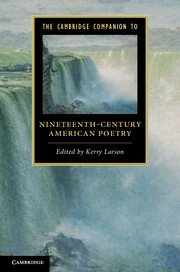Book contents
- Frontmatter
- Introduction
- I MANDATES, MOVEMENTS, AND MANIFESTOES
- II INDIVIDUAL AUTHORS
- 8 Longfellow’s ambivalence
- 9 Sarah Piatt’s grammar of convention and the conditions of authorship
- 10 Poe and Southern poetry
- 11 The color line: James Monroe Whitfield and Albery Allson Whitman
- 12 Colonial violence and poetic transcendence in Whitman’s “Song of Myself”
- 13 Emily Dickinson’s “turbaned seas”
- Selected guide to further reading
- Index
- Cambridge Companions to…
13 - Emily Dickinson’s “turbaned seas”
from II - INDIVIDUAL AUTHORS
Published online by Cambridge University Press: 28 November 2011
- Frontmatter
- Introduction
- I MANDATES, MOVEMENTS, AND MANIFESTOES
- II INDIVIDUAL AUTHORS
- 8 Longfellow’s ambivalence
- 9 Sarah Piatt’s grammar of convention and the conditions of authorship
- 10 Poe and Southern poetry
- 11 The color line: James Monroe Whitfield and Albery Allson Whitman
- 12 Colonial violence and poetic transcendence in Whitman’s “Song of Myself”
- 13 Emily Dickinson’s “turbaned seas”
- Selected guide to further reading
- Index
- Cambridge Companions to…
Summary
Most popular and scholarly accounts of Dickinson represent her at home – that is, on 280 Main Street in Amherst, Massachusetts, Dickinson's residence from 1830 to 1840 and from 1855 until her death in 1886. By the age of 30, in 1860, she was relatively reclusive, and in 1865 she wrote to Thomas Wentworth Higginson that “To an Emigrant, Country is idle except it be his own … I do not cross my Father's ground to any House or town” (L330). Cartoonists have memorably portrayed Dickinson as running a travel agency advertising special deals for staying at home, or keeping a schedule that marks as momentous plans to go to the pantry or the garden. This notorious reclusiveness has encouraged scholarly neglect of ways that Dickinson's writing was shaped by the world beyond Amherst. Such neglect is being remedied in relation to the Civil War, an increasingly obvious influence on Dickinson's writing. No one would now repeat Thomas H. Johnson's infamous dictum that Dickinson “did not live in history and held no view of it.” Very little attention has been paid, however, to the ways in which the international spectrum of cultures and events played into her poetics. Dickinson did not write poems “about” international exchange but she was part of a community that perceived its material pleasures, republican principles, and beliefs in relation to global commerce.
- Type
- Chapter
- Information
- The Cambridge Companion to Nineteenth-Century American Poetry , pp. 248 - 264Publisher: Cambridge University PressPrint publication year: 2011
- 2
- Cited by

